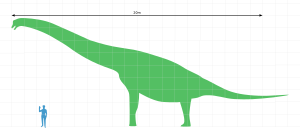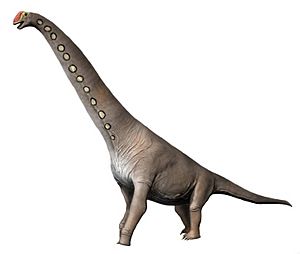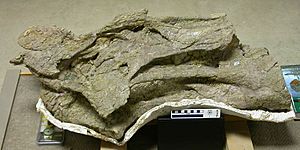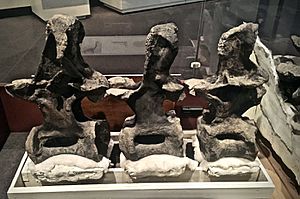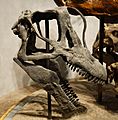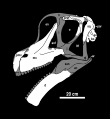Brachiosaurus facts for kids
Quick facts for kids Brachiosaurus |
|
|---|---|
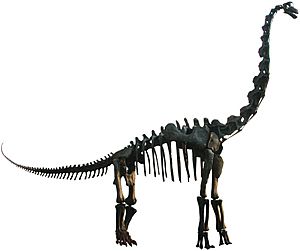 |
|
| Reconstructed replica of the holotype skeleton outside the Field Museum of Natural History | |
| Scientific classification | |
| Genus: |
Brachiosaurus
|
| Species: |
altithorax
|
Brachiosaurus is a genus of sauropod dinosaur that lived in North America during the Late Jurassic, about 154 to 150 million years ago. It was first described by American paleontologist Elmer S. Riggs in 1903 from fossils found in the Colorado River valley in western Colorado, United States. Riggs named the dinosaur Brachiosaurus altithorax; the generic name is Greek for "arm lizard", in reference to its proportionately long arms, and the specific name means "deep chest".
Brachiosaurus is estimated to have been between 18 and 22 meters (59 and 72 ft) long; body mass ranged from 28.3 to 46.9 metric tons (31.2 and 51.7 short tons). It had a disproportionately long neck, small skull, and large overall size, all of which are typical for sauropods. Atypically, Brachiosaurus had longer forelimbs than hindlimbs, which resulted in a steeply inclined trunk, and a proportionally shorter tail.
Brachiosaurus is the namesake genus of the family Brachiosauridae, which includes a handful of other similar sauropods. Most popular depictions of Brachiosaurus are in fact based on Giraffatitan, a genus of brachiosaurid dinosaur from the Tendaguru Formation of Tanzania. Giraffatitan was originally described by German paleontologist Werner Janensch in 1914 as a species of Brachiosaurus, B. brancai, but moved to its own genus in 2009. Three other species of Brachiosaurus have been named based on fossils found in Africa and Europe; two are no longer considered valid, and a third has become a separate genus, Lusotitan.
Among the most iconic and initially thought to be one of the largest dinosaurs, Brachiosaurus has appeared in popular culture, notably in the 1993 film Jurassic Park.
Contents
History of discovery
The genus Brachiosaurus is based on a partial postcranial skeleton discovered in 1900 in the valley of the Colorado River near Fruita, Colorado. This specimen, which was later declared the holotype, comes from rocks of the Brushy Basin Member of the Morrison Formation, and therefore is late Kimmeridgian in age, about 154 to 153 million years old. It was discovered by American paleontologist Elmer S. Riggs and his crew from the Field Columbian Museum (now the Field Museum of Natural History) of Chicago.
Stanton Merill Bradbury, a dentist in Grand Junction, sent a letter to Riggs writing that dinosaur bones had been collected near Grand Junction since 1885. Bradbury was an amateur collector himself and president of the Western Colorado Academy of Science. Riggs was skeptical of this claim, but his superior, curator of geology Oliver Cummings Farrington, was very eager to add a large sauropod skeleton to the collection to outdo other institutions, and convinced the museum management to invest five hundred dollars in an expedition. The group arrived on June 20, 1900 and set camp at the abandoned Goat Ranch. During a prospecting trip on horseback, Riggs's field assistant Harold William Menke found the humerus of a dinosaur, on July 4, exclaiming it was "the biggest thing yet!". It soon proved to be of enormous size, convincing a puzzled Riggs that he had discovered the largest land animal ever.
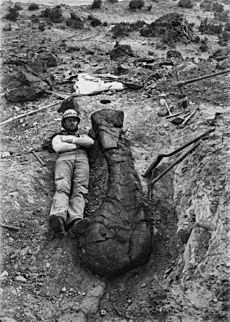
The site, Riggs Quarry 13, is located on a small hill later known as Riggs Hill; it is today marked by a plaque. More Brachiosaurus fossils are reported on Riggs Hill, but other fossil finds on the hill have been vandalized.
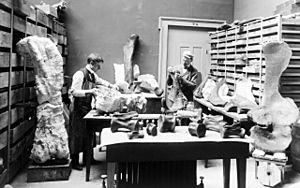
Riggs published a short report of the new find in 1901, noting the unusual length of the humerus compared to the femur and the extreme overall size and the resulting giraffe-like proportions, as well as the lesser development of the tail, but did not publish a name for the new dinosaur. In 1903, he named the type species Brachiosaurus altithorax. Riggs derived the genus name from the Greek brachion/βραχίων meaning "arm" and sauros/σαυρος meaning "lizard", because he realized that the length of the arms was unusual for a sauropod. The specific epithet was chosen because of the unusually deep and wide chest cavity, from Latin altus "deep" and Greek thorax/θώραξ, "breastplate, cuirass, corslet". Latin thorax was derived from the Greek and had become a usual scientific designation for the chest of the body. The titles of Riggs's 1901 and 1903 articles emphasized that the specimen was the "largest known dinosaur". Riggs followed his 1903 publication with a more detailed description in a monograph in 1904.
Description
Size
The length of Brachiosaurus has been estimated at 20–22 meters (66–72 ft) and 18 meters (59 ft), and its height at 9.4 meters (30+3⁄4 ft) and 12–13 meters (39–43 ft).
General build
Like all sauropod dinosaurs, Brachiosaurus was a quadruped with a small skull, a long neck, a large trunk with a high-ellipsoid cross section, a long, muscular tail and slender, columnar limbs. Large air sacs connected to the lung system were present in the neck and trunk. The neck is not preserved in the holotype specimen, but was very long even by sauropod standards in the closely related Giraffatitan, consisting of thirteen elongated cervical (neck) vertebrae. The neck was held in a slight S-curve, with the lower and upper sections bent and a straight middle section.
Brachiosaurus differed in its body proportions from the closely related Giraffatitan. The trunk was about 25 to 30 percent longer, resulting in a dorsal vertebral column longer than the humerus. Only a single complete caudal (tail) vertebra has been discovered, but its great height suggests that the tail was larger than in Giraffatitan. Unlike Giraffatitan and other sauropods, which had vertically oriented forelimbs, the arms of Brachiosaurus appear to have been slightly sprawled at the shoulder joints. The humerus was less slender than that of Giraffatitan, while the femur had similar proportions. This might indicate that the forelimbs of Brachiosaurus supported a greater fraction of the body weight than is the case for Giraffatitan.
Habits
It was believed throughout the nineteenth and early twentieth centuries that sauropods like Brachiosaurus were too massive to support their own weight on dry land, and instead lived partly submerged in water. Riggs, affirming observations by John Bell Hatcher, was the first to defend in length that most sauropods were fully terrestrial animals in his 1904 account on Brachiosaurus, pointing out that their hollow vertebrae have no analogue in living aquatic or semiaquatic animals, and their long limbs and compact feet were suitable for moving on the ground. Brachiosaurus would have been better adapted than other sauropods to a fully terrestrial lifestyle through its slender limbs, high chest, wide hips, high ilia and short tail. In 1990 the paleontologist Stephen Czerkas stated that Brachiosaurus could have entered water occasionally to cool off (thermoregulate).
Neck posture
Ongoing debate revolves around the neck posture of brachiosaurids, with estimates ranging from near-vertical to horizontal orientations. The idea of near-vertical postures in sauropods in general was popular until 1999, when Stevens and Parrish argued that the sauropod neck was not flexible enough to be held in an upright, S-curved pose, and instead was held horizontally. Reflecting this research, various newspapers ran stories criticizing the Field Museum Brachiosaurus mount for having an upward curving neck. Museum paleontologists Olivier Rieppel and Christopher Brochu defended the posture in 1999, noting the long forelimbs and upward sloping backbone. They also stated that the most developed neural spines for muscle attachment being positioned in the region of the shoulder girdle would have permitted the neck to be raised in a giraffe-like posture. Furthermore, such a pose would have required less energy than lowering its neck, and the inter-vertebral discs would not have been able to counter the pressure caused by a lowered head for extended periods of time (though lowering its neck to drink must have been possible). Some recent studies also advocated a more upward directed neck. Christian and Dzemski (2007) estimated that the middle part of the neck in Giraffatitan was inclined by sixty to seventy degrees; a horizontal posture could be maintained only for short periods of time.
With their heads held high above the heart, brachiosaurids would have had stressed cardiovascular systems. It is estimated that the heart of Brachiosaurus would have to pump double the blood pressure of a giraffe to reach the brain, and possibly weighed 400 kg (880 lb). The distance between head and heart would have been reduced by the S-curvature of the neck by more than 2 meters (6+1⁄2 ft) in comparison to a totally vertical posture. The neck may also have been lowered during locomotion by twenty degrees. In studying the inner ear of Giraffatitan, Gunga & Kirsch (2001) concluded that brachiosaurids would have moved their necks in lateral directions more often than in dorsal-ventral directions while feeding.
Feeding and diet
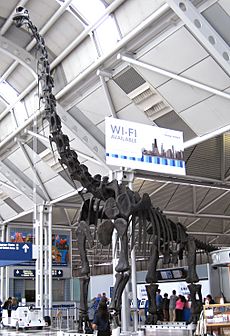
Brachiosaurus is thought to have been a high browser, feeding on foliage well above the ground. Even if it did not hold its neck near vertical, and instead had a less inclined neck, its head height may still have been over 9 meters (30 ft) above the ground. It probably fed mostly on foliage above 5 meters (16 ft). It also might have fed lower at times, between 3 and 5 meters (9.8 and 16.4 ft) up. Its diet likely consisted of ginkgos, conifers, tree ferns, and large cycads, with intake estimated at 200 to 400 kilograms (440 to 880 lb) of plant matter daily in a 2007 study. Brachiosaurid feeding involved simple up-and-down jaw motion. As in other sauropods, animals would have swallowed plant matter without further oral processing, and relied on hindgut fermentation for food processing. The teeth were somewhat spoon-shaped and chisel-like. Such teeth are optimized for non-selective nipping, and the relatively broad jaws could crop large amounts of plant material.
Even if a Brachiosaurus of forty tonnes had to eat half a tonne of fodder. If it fed sixteen hours per day, biting off between a tenth and two-thirds of a kilogram, taking between one and six bites per minute, its daily food intake would have equaled roughly 1.5 percent of its body mass, comparable to the requirement of a modern elephant.
It has been suggested that Brachiosaurus could rear on its hind legs to feed, using its tail for extra ground support. A bipedal stance might have been adopted by Brachiosaurus in exceptional situations, like male dominance fights. The downward mobility of the neck of Brachiosaurus would have allowed it to reach open water at the level of its feet, while standing upright.
Metabolism
Like other sauropods, Brachiosaurus probably maintained a stable internal temperature and controlled body temperature through internal means.
Air sacs
The respiration system of sauropods, like that of birds, made use of air sacs. There was not a bidirectional airflow as with mammals, in which the lungs function as bellows, first inhaling and then exhaling air. Instead the air was sucked from the trachea into an abdominal air sac in the belly which then pumped it forward through the parabronchi, air loops, of the stiff lung. Valves prevented the air from flowing backward when the abdominal air sac filled itself again; at the same time a cervical air sac at the neck base sucked out the spent air from the lung. Both air sacs contracted simultaneously to pump the used air out of the trachea. This procedure guaranteed a unidirectional airflow, the air always moving in a single forward direction in the lung itself. This significantly improved the oxygen intake and the release of carbon dioxide. Not only was dead air removed quickly but also the blood flow in the lung was counterdirectional in relation to the airflow, leading to a far more effective gas exchange.
Cultural significance
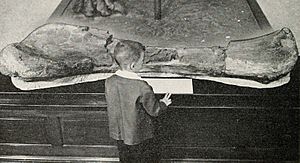
Brachiosaurus has been called one of the most iconic dinosaurs, but most popular depictions are based on the African species B. brancai which has since been moved to its own genus, Giraffatitan. A main belt asteroid, 1991 GX7, was named 9954 Brachiosaurus in honor of the genus in 1991. Brachiosaurus was featured in the 1993 movie Jurassic Park, as the first computer generated dinosaur shown. These effects were considered ground-breaking at the time, and the awe of the movie's characters upon seeing the dinosaur for the first time was mirrored by audiences. The movements of the movie's Brachiosaurus were based on the gait of a giraffe combined with the mass of an elephant. A scene later in the movie used an animatronic head and neck, for when a Brachiosaurus interacts with human characters. The digital model of Brachiosaurus used in Jurassic Park later became the starting point for the ronto models in the 1997 special edition of the film Star Wars Episode IV: A New Hope.
-
O. C. Marsh's outdated 1891 skeletal reconstruction of Brontosaurus, with skull inaccurately based on that of the Felch Quarry Brachiosaurus
-
Scapulocoracoid BYU 9462 has been seen as a possible Brachiosaurus bone; it was originally assigned to Ultrasauros (now a junior synonym of Supersaurus), Museum of Ancient Life
-
Referred forelimb bone (humerus) from Potter Creek, USNM 21903
-
Skeleton of Giraffatitan, formerly B. brancai, Natural History Museum, Berlin
-
Vertebral anatomy of the holotype skeleton. Top: sixth dorsal vertebra in back (A) and right side view (B). Bottom: second caudal vertebra in back (C) and side view (D).
-
Reconstruction of the Felch Quarry Brachiosaurus skull, Denver Museum of Nature & Science
-
Juvenile B. sp. specimen SMA 0009, nicknamed Toni. The skull is reconstructed following the initial diplodocoid identification), Sauriermuseum Aathal.
See also
 In Spanish: Brachiosaurus altithorax para niños
In Spanish: Brachiosaurus altithorax para niños



